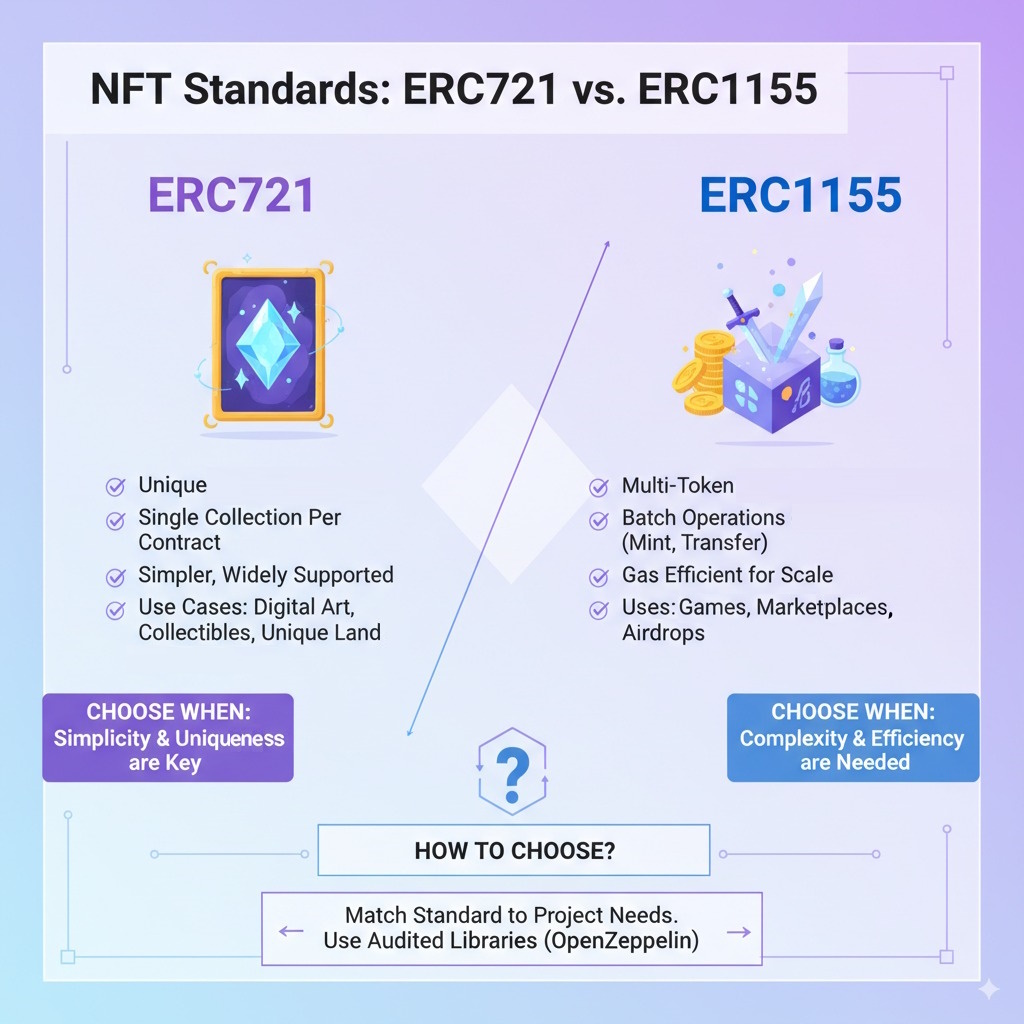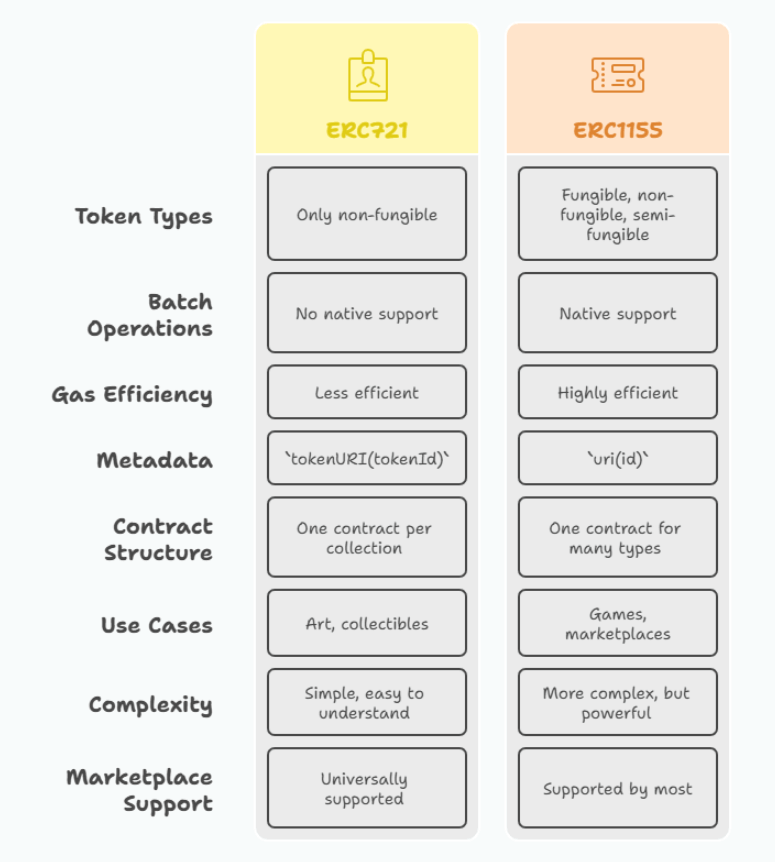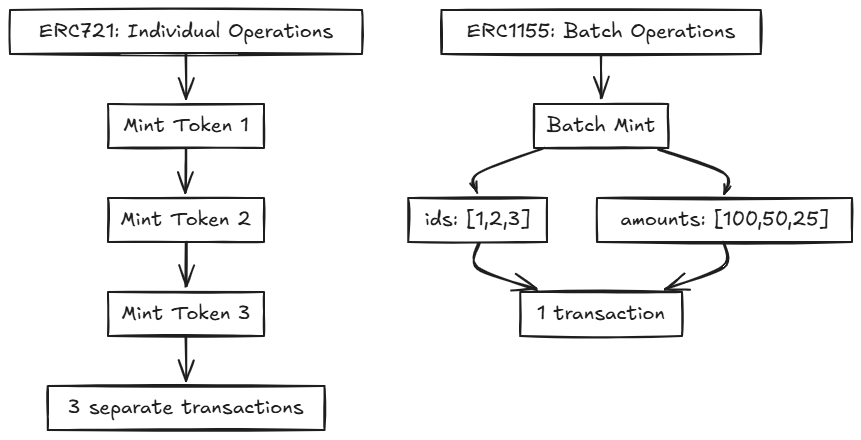ERC721 vs. ERC1155: Key Differences, Use Cases & How to Choose
TL;DR: ERC721 vs ERC1155
- ERC721: Best for unique, one-of-a-kind NFTs (art, collectibles). Simple, widely supported, and ideal for projects where every token is distinct.
- ERC1155: Best for projects needing multiple token types (fungible, non-fungible, semi-fungible) and batch operations (games, marketplaces). More efficient for large-scale or complex ecosystems.
- Use ERC721 for simple, unique assets. Use ERC1155 for complex, multi-asset projects or when you need batch minting/transfers.
1. Navigating Ethereum's NFT Standards
Ethereum's NFT ecosystem is built on robust token standards that ensure interoperability and security. ERC721 was the first standard for unique, non-fungible assets, powering the early NFT boom. As NFT use cases grew (especially in gaming and large-scale collectibles), ERC1155 emerged to address the need for efficiency, batch operations, and multi-token management.
This guide is designed to help you decide which standard is right for your project. If you want a deep technical dive into ERC721 implementation, see our Mastering ERC721: Developer Guide to NFT Metadata & Best Practices.
This guide compares ERC721 and ERC1155, helping you choose the right standard for your project.

Figure: ERC721 vs ERC1155 overview.
2. ERC721: The Essence of Unique NFTs
ERC721 is designed for truly unique, non-fungible assets.
- Each token has a unique
tokenIdand owner. - The contract typically represents a single collection (e.g., 10,000 unique art pieces).
Key Features:
- Uniqueness: Every token is distinct.
- Non-Fungibility: Tokens are not interchangeable.
- Standard Interface: Functions like
ownerOf(tokenId),transferFrom(from, to, tokenId), andapprove(to, tokenId). - Metadata: Each token can have a unique URI via
tokenURI(tokenId).
Best for:
- Digital art
- High-value collectibles
- Unique virtual land
- Certificates and licenses
Solidity Example:
// SPDX-License-Identifier: MIT
pragma solidity ^0.8.0;
import "@openzeppelin/contracts/token/ERC721/ERC721.sol";
contract MyNFT is ERC721 {
constructor() ERC721("MyNFT", "MNFT") {}
function mint(address to, uint256 tokenId) public {
_mint(to, tokenId);
}
}
3. ERC1155: The Multi-Token Standard
ERC1155 allows a single contract to manage multiple token types: fungible, non-fungible, and semi-fungible.
Key Features:
- Multi-token support: One contract, many token types (each with a unique
id). - Batch operations: Mint, transfer, or burn multiple tokens in a single transaction.
- Supports fungible, non-fungible, and semi-fungible tokens.
- Efficient for games, marketplaces, and large-scale projects.
Solidity Example:
// SPDX-License-Identifier: MIT
pragma solidity ^0.8.0;
import "@openzeppelin/contracts/token/ERC1155/ERC1155.sol";
contract MyGameItems is ERC1155 {
constructor() ERC1155("https://game.example/api/item/{id}.json") {}
function mint(address to, uint256 id, uint256 amount) public {
_mint(to, id, amount, "");
}
}
Note: If you need per-token URIs (each token ID has its own unique metadata URI), OpenZeppelin 5.x provides the
ERC1155URIStorageextension. This allows you to set and manage individual URIs for each token ID, similar to howERC721URIStorageworks for ERC721 tokens.
4. Key Differences: ERC721 vs. ERC1155

Figure: Comparison of ERC721 and ERC1155 token types and their characteristics.
| Feature | ERC721 | ERC1155 |
|---|---|---|
| Token Types | Only non-fungible (unique) | Fungible, non-fungible, semi-fungible (all in one contract) |
| Batch Operations | No native support | Native support for batch mint, transfer, burn |
| Gas Efficiency | Less efficient for multiple tokens | Highly efficient for batch operations |
| Metadata | tokenURI(tokenId) per token | uri(id) with {id} placeholder, supports dynamic metadata |
| Contract Structure | One contract per collection/type | One contract for many types |
| Use Cases | Art, collectibles, unique assets | Games, marketplaces, airdrops, mixed asset types |
| Complexity | Simple, easy to understand | More complex, but powerful |
| Marketplace Support | Universally supported | Supported by most, but not all, marketplaces |
Contract Architecture Comparison

Figure: ERC721 requires separate contracts for each collection, while ERC1155 can manage multiple token types in one contract.
Batch Operations Flow

Figure: ERC1155's batch operations allow multiple token operations in a single transaction, significantly reducing gas costs.
5. When to Use ERC721
Despite the advantages of ERC1155 in certain scenarios, ERC721 remains a highly relevant and often preferred standard for specific types of NFT projects. Its strengths lie in its simplicity and direct representation of unique, indivisible assets.
Choose ERC721 when:
- The project revolves around truly unique, individual items: This is the classic use case for ERC721. Examples include:
- Digital Art: One-of-a-kind artworks where each piece is distinct and not part of a larger batch of identical items.
- High-Value Collectibles: Rare items where individual identity and provenance are paramount (e.g., CryptoPunks, Bored Ape Yacht Club).
- Unique Virtual Land Parcels: If each land parcel in a metaverse has distinct characteristics and is not part of a fungible set (though some metaverses now use ERC1155 for land to batch operations).
- Certificates and Licenses: Unique, non-transferable (or restricted transfer) certificates of authenticity, diplomas, or licenses tied to an individual.
- Simplicity is a priority and batch operations are not a primary concern: If the project does not require managing multiple types of tokens within one contract, and the volume of minting or transfers is low enough that gas efficiency from batching is not a critical factor, ERC721's simpler conceptual model can be advantageous.
- The ecosystem and tooling are more familiar: ERC721 has been around longer, and while ERC1155 support is widespread, some older tools or platforms might have more mature or specific integrations for ERC721. However, this is becoming less of a differentiating factor.
- Each token requires distinct, individual metadata management: While ERC1155 can also link to unique metadata per ID, ERC721's
tokenURI(tokenId)directly maps a unique token to its metadata, which can feel more straightforward for collections of purely unique items.
The core idea is that if your project is focused on items where each one is a standalone, indivisible entity, and you don't need the overhead or features of managing fungible or semi-fungible tokens alongside them, ERC721 provides a robust and well-understood solution.
6. When to Use ERC1155
ERC1155's power and efficiency shine in projects with more complex token economies or those requiring the management of diverse asset types within a single ecosystem. Its ability to handle fungible, non-fungible, and semi-fungible tokens, coupled with batch operations, makes it ideal for a range of modern Web3 applications.
Choose ERC1155 when:
- The project involves multiple token types: If your application needs to manage different kinds of assets, such as in-game currency (fungible), unique collectible items (non-fungible), and perhaps consumable items with multiple copies (semi-fungible), ERC1155 allows all of these to be managed within a single smart contract. This drastically reduces deployment costs and simplifies contract management compared to deploying separate ERC20 and ERC721 contracts.
- Example: A blockchain game might have Gold (FT), Swords (NFTs with unique stats), and Health Potions (SFTs, where each potion is identical but distinct from other item types) all managed by one ERC1155 contract.
- Batch minting, transferring, or burning is required: For scenarios involving large numbers of tokens, such as airdrops, initial game item distributions, or large-scale marketplace operations, ERC1155's batch functions provide significant gas savings and reduce network congestion.
- Example: Minting 10,000 in-game items or transferring 100 different NFTs to a user can be done much more efficiently with ERC1155's batch capabilities.
- Gas efficiency is a critical concern: Due to batch operations and a consolidated contract structure, ERC1155 generally offers lower transaction costs for managing multiple tokens or performing multiple operations simultaneously.
- Semi-Fungible Tokens (SFTs) are needed: If your project requires tokens that are fungible within their own class but non-fungible compared to others (e.g., event tickets for different seating sections, vouchers for specific services, or game items with limited editions but multiple copies), ERC1155 is the natural choice.
- Building NFT Marketplaces or Platforms with Diverse Assets: Marketplaces that aim to support a wide variety of items, including both unique collectibles and items with multiple copies, can benefit from ERC1155's flexibility.
- Fractional Ownership (Potentially): While not its primary design, ERC1155's ability to manage quantities of specific token IDs can be adapted to represent fractional ownership of an underlying asset.
The decision to use ERC1155 often comes down to the need for efficiency at scale and the requirement to manage a diverse portfolio of token types without the overhead of multiple contract deployments.
7. Implementation Tips with OpenZeppelin
Regardless of which standard is chosen, leveraging OpenZeppelin's extensively audited and community-vetted contract libraries is a highly recommended best practice for secure and standard-compliant development.
-
OpenZeppelin for ERC721: OpenZeppelin provides
ERC721.solas a base implementation, along with extensions likeERC721URIStorage.solfor metadata management,ERC721Enumerable.solfor on-chain token enumeration, andERC721Burnable.solfor token destruction. The OpenZeppelin Contracts Wizard can also generate a customized ERC721 contract based on selected features. -
OpenZeppelin for ERC1155: OpenZeppelin offers a robust
ERC1155.solimplementation that simplifies the development of multi-token contracts. It includes:- Core ERC1155 functionalities:
balanceOf,balanceOfBatch,safeTransferFrom,safeBatchTransferFrom,setApprovalForAll,isApprovedForAll. - Internal minting functions:
_mint(to, id, amount, data)and_mintBatch(to, ids, amounts, data)for creating new tokens. - Internal burning functions:
_burn(from, id, amount)and_burnBatch(from, ids, amounts). - Metadata URI management: An internal
_setURI(string newuri)function for setting the base URI, and the publicuri(uint256 id)function which typically appends the tokenidto this base URI (often with{id}substitution). - Extensions like
ERC1155Pausable.solfor pausing token operations andERC1155Burnable.solfor allowing holders to burn their tokens.
- Core ERC1155 functionalities:
Using OpenZeppelin significantly reduces the boilerplate code and potential for errors in implementing these complex standards, allowing developers to focus on their project's unique features and business logic.
8. Real-World Examples
- ERC721: CryptoPunks, Bored Ape Yacht Club, unique digital art.
- ERC1155: Axie Infinity (game items), Enjin (multi-asset gaming), large-scale airdrops.
9. Further Reading
- OpenZeppelin ERC721 Docs
- OpenZeppelin ERC1155 Docs
- Mastering ERC721: Developer Guide to NFT Metadata & Best Practices
10. Conclusion
There's no one-size-fits-all answer.
- ERC721 is perfect for simple, unique NFTs.
- ERC1155 is ideal for complex, multi-asset, or high-volume projects.
Choose the standard that fits your project's needs, and try to use audited libraries like OpenZeppelin for security.
Want to see these standards in action? Try the Tokenization Challenge!
Already comfortable with the basics? Try the SVG NFT Challenge!